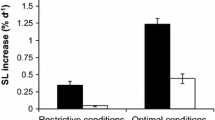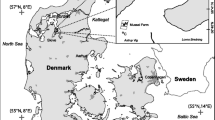Abstract
Physiological responses of suspended cultured mussels, Mytilus edulis L., in two Scottish sea lochs (Lochs Etive and Leven) were investigated in their native and transplanted environments, after 15 d, 4.5 mo and 1 yr acclimatization, during the main growing season of May to September 1992. These measurements were integrated by means of the balanced energy equation, and “scope for growth” was calculated to assess the performance of each stock. Transplanted mussels showed clear signs of stress during the first 15 d after transfer, with low clearance rates and energy retention and high rates of respiration and nitrogen excretion. There were significant differences in some of the physiological responses (clearance, respiration and excretion rates), scope for growth and growth efficiency between the native populations, with the responses of mussels in Loch Etive being more favourable than those in Loch Leven. With newly transplanted mussels after 15 d acclimatization, almost all these measurements also differed significantly from native mussels in their host site and the original stocks but, with the exception of ammonia excretion rates, all the variables of cross-transplanted mussels after 4.5 mo acclimatization were the same as those of the native stock at the host site. Good agreement between observed long-term growth rates and estimated scope for growth suggests that, like growth rate, differences in physiological responses are mainly controlled by environmental factors; i.e., stock or origin had no significant influence on variations in physiological response (except ammonia excretion). The results further indicate that scope for growth estimated during the main growing season can be used to assess the actual growth rate and to compare sites for on-growing.
Similar content being viewed by others
References
Bayne BL, Moore MN, Widdows J, Livingstone DR (1979) Measurements of the responses of individuals to environmental stress and pollution: studies with bivalve molluscs. Phil Trans R Soc (Ser B) 286: 563–581
Bayne BL, Widdows J (1978) The physiological ecology of two populations of Mytilus edulis (L.). Oecologia 37: 137–162
Bayne BL, Worrall CM (1980) Growth and production of mussels, Mytilus edulis, from two populations. Mar Ecol Prog Ser 3: 317–328
Carver CEA, Mallet AL (1990) Estimating the carrying capacity of a coastal inlet for mussel culture. Aquaculture, Amsterdam 88: 39–53
Deslous-Paoli JM, Boromthanarat S, Héral M, Boromthanarat W, Razet D (1990) Energy budget of a Mytilus edulis (L.) population during its first year on bouchots in the bay of Marennes Oléron. Aquaculture, Amsterdam 91: 49–63
Hawkins AJS, Bayne BL, Day AJ, Rusin J, Worrall CM (1989) Genotype-dependent interrelations between energy metabolism, protein metabolism and fitness. In: Ryland JS, Tyler PA (eds) Reproduction, genetics and distributions of marine organisms. Olsen&Olsen, Fredensborg, p 283–292
Navarro E, Iglesias JIP, Camacho AP, Labarta U, Beiras R (1991) The physiological energetics of mussels (Mytilus galloprovincialis Lmk) from different cultivation rafts in the Ría de Arosa (Galicia NW Spain). Aquaculture, Amsterdam 94: 197–212
Okumuş İ (1993) Evaluation of suspended mussel (Mytilus edulis L.) culture and integrated experimental mariculture with salmon in Scottish sea lochs. PhD thesis. University of Stirling
Okumuş İ, Stirling HP (1994) Growth and production of mussels (Mytilus edulis L.) suspended at salmon marine cages and mussel farms in two sea lochs on the West Coast of Scotland. Aquaculture, Amsterdam (in press)
Rodhouse PG, Roden CM, Hensey MP, Ryan TH (1984) Resource allocation in Mytilus edulis on the shore and in suspended culture. Mar Biol 84: 27–34
Stirling HP, Okumuş İ (1994) Growth, mortality and shell morphology of cultivated mussel (Mytilus edulis) stocks cross-transplanted between two Scottish sea lochs. Mar Biol 119: 115–123
Strickland JDH, Parsons TR (1972) A practical handbook of seawater analysis. 2nd edn. Bull Fish Res Bd Can 167: 1–310
Tedengren M, André C, Johannesson K, Kautsky N (1990) Genotypic and phenotypic differences between Baltic and North Sea populations of Mytilus edulis evaluated through reciprocal transplantations. III. Physiology. Mar Ecol Prog Ser 59: 221–227
Tedengren M, Kautsky N (1986) Comparative study of the physiology and its probable effect on size in blue mussels (Mytilus edulis L.) from the North Sea and the Northern Baltic proper. Ophelia 25: 147–155
Thompson RJ (1984) The reproductive cycle and physiological ecology of the mussel Mytilus edulis in a subarctic, non-estuarine environment. Mar Biol 79: 277–288
Widdows J (1978) Physiological indices of stress in Mytilus edulis J mar biol Ass UK 58: 125–142
Widdows J (1985a) Physiological measurements. In: Bayne BL et al (eds) The effects of stress and pollution on marine animals. Praeger, New York, p 3–45
Widdows J (1985b) Physiological procedures: In: Bayne BL et al (ed) The effects of stress and pollution on marine animals. Praeger, New York, p 161–178
Widdows J, Donkin P, Salkeld PN, Cleary JJ, Lowe DM, Evans SV, Thomson PE (1984) Relative importance of environmental factors in determining physiological differences between two populations of mussels (Mytilus edulis). Mar Ecol Prog Ser 17: 33–47
Widdows J, Fieth P, Worrall CM (1979) Relationship between seston, available food and feeding activity in the common mussel Mytilus edulis. Mar Biol 50: 195–207
Widdows J, Johnson D (1988) Physiological energetics of Mytilus edulis: scope for growth. Mar Ecol Prog Ser 46: 113–121
Winter JE (1978) A review on the knowledge of suspension-feeding in lamellibranchiate bivalves, with special reference to artificial aquaculture systems. Aquaculture, Amsterdam 13: 1–133
Author information
Authors and Affiliations
Additional information
Communicated by J. Mauchline, Oban
Rights and permissions
About this article
Cite this article
Okumuş, İ., Stirling, H.P. Physiological energetics of cultivated mussel (Mytilus edulis) populations in two Scottish west coast sea lochs. Marine Biology 119, 125–131 (1994). https://doi.org/10.1007/BF00350114
Received:
Accepted:
Issue Date:
DOI: https://doi.org/10.1007/BF00350114




